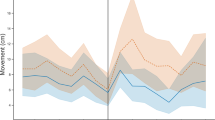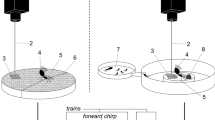Abstract
Communication signals used in animal social interactions are frequently performed repetitively, but the function of this repetition is often not well understood. We examined the effects of signal repetition by investigating the behavior of worker honey bees that received differing numbers of vibration signals in established and newly founded colonies, which could use signal repetition differently to help adjust task allocations to the labor demands associated with the different stages of colony development. In both colony types, more than half of all monitored workers received more than one vibration signal, and approximately 12% received ≥5 signals during a given 20-min observation period. Vibrated recipients exhibited greater activity and task performance than same-age non-vibrated controls at all levels of signal activity. However, vibrated workers showed similar levels of task performance, movement rates, cell inspection rates, and trophallactic exchanges regardless of the number of signals received. Thus, the repeated performance of vibration signals on individual bees did not cause cumulative increases in the activity of certain workers, but rather may have functioned to maintain relatively constant levels of activity and task performance among groups of recipients. The established and newly founded colonies did not differ in the extent to which individual workers received the different numbers of vibration signals or in the levels of activity stimulated by repeated signals. Previous work has suggested that compared to established colonies, newly founded colonies have a greater number of vibrators that perform signals on a greater proportion of the workers they contact. Taken in concert, these results suggest that vibration signal repetition may help to adjust task allocations to the different stages of colony development by helping to maintain similar levels of activity among a greater total number of recipients, rather than by eliciting cumulative effects that cause certain recipients to work harder than others.




Similar content being viewed by others
References
Anderson C, McShea DW (2001) Individual versus social complexity, with particular reference to ant colonies. Biol Rev 76:211–237
Beekman M, Sumpter DJT, Seraphides N, Ratnieks FLW (2004) Comparing foraging behaviour of small and large honey-bee colonies by decoding waggle dances made by foragers. Functional Ecol 18:829–835
Biesmeijer JC (2003) The occurrence and context of the shaking signal in honey bees (Apis mellifera) exploiting natural food sources. Ethology 109:1009–1020
Bradbury JW, Vehrencamp SL (1998) Principles of animal communication. Sinauer, Sunderland
Cao TT, Hyland KM, Malechuk A, Lewis LA, Schneider SS (2007) The influence of the vibration signal on worker interactions with the nest and nest mates in established and newly founded colonies of the honey bee, Apis mellifera. Insect Soc 54:144–149
De Marco RJ, Gurevitz JM, Menzel R (2008) Variability in the encoding of spatial information by dancing bees. J Exp Biol 211:1635–1644
Donahoe K, Lewis LA, Schneider SS (2003) The role of the vibration signal in the house-hunting process of honey bee (Apis mellifera) swarms. Behav Ecol Sociobiol 54:593–600
Dreller C, Tarpy DR (2000) Perception of the pollen need by foragers in a honeybee colony. Anim Behav 59:91–96
Eckert CD, Winston ML, Ydenberg RC (1994) The relationship between population size, amount of brood, and individual foraging behaviour in the honey bee, Apis mellifera L. Oecologia 97:248–255
Fewell JH (2003) Social insect networks. Science 301:1867–1870
Fewell JH, Winston ML (1996) Regulation of nectar collection in relation to honey storage levels by honey bees, Apis mellifera. Behav Ecol 7:286–291
Fletcher DJC (1975) Significance of dorsoventral abdominal vibration among honey-bees (Apis mellifera L). Nature 256:721–723
Fuchs S (1976) The response to vibrations of the substrate and reactions to the specific drumming in colonies of Carpenter ants (Camponotus, Formicidae, Hymenoptera). Behav Ecol Sociobiol 1:155–184
Grüter C, Acosta LE, Farina WM (2006) Propagation of olfactory information within the honeybee hive. Behav Ecol Sociobiol 60:707–715
Hölldobler B, Wilson EO (1990) The ants. Springer, New York
Hyland KM, Cao TT, Malechuk AM, Lewis LA, Schneider SS (2007) Vibration signal behaviour and the use of modulatory communication in established and newly founded honeybee colonies. Anim Behav 73:541–551
Lewis LA, Schneider SS (2000) The modulation of worker behavior by the vibration signal during house hunting in swarms of the honey bee, Apis mellifera. Behav Ecol Sociobiol 48:154–164
Lewis LA, Schneider SS, DeGrandi-Hoffman G (2002) Factors influencing the selection of recipients by workers performing vibration signals in colonies of the honeybee, Apis mellifera. Anim Behav 63:361–367
Loughry WJ, McDonough CM (1988) Calling and vigilance in California ground squirrels: a test of the tonic communication hypothesis. Anim Behav 36:1533–1540
Markl H (1985) Manipulation, modulation, information, cognition: some of the riddles of communication. In: Hölldobler B, Lindauer M (eds) Experimental behavioral ecology and sociobiology. Fisher, Stuttgart, pp 163–194
O’Donnell S (2003) The development of biting interactions and task performance in a tropical eusocial wasp. Behaviour 140:255–267
O’Donnell S (2006) Polybia wasp biting interactions recruit foragers following experimental worker removals. Anim Behav 71:709–715
O’Donnell S, Bulova SJ (2007a) Worker connectivity: a review of the design of worker communication systems and their effects on task performance in insect societies. Insect Soc 54:203–210
O’Donnell S, Bulova SJ (2007b) Worker connectivity: a simulation model of variation in worker communication and its effects on task performance. Insect Soc 54:211–218
Owings DH, Hennessy DF, Leger DW, Gladney AB (1986) Different functions of ‘alarm’ calling for different time scales: a preliminary report on ground squirrels. Behaviour 99:101–116
Painter-Kurt S, Schneider SS (1998) Age and behavior of honey bees, Apis mellifera (Hymenoptera: Apidae), that perform vibration signals on workers. Ethology 104:457–473
Pankiw T (2004) Cued in: honey bee pheromones as information flow and collective decision-making. Apidologie 35:217–226
Pierce AL, Lewis LA, Schneider SS (2007) The use of the vibration signal and worker piping to influence queen behavior during swarming in honey bees, Apis mellifera. Ethology 113:267–275
Rice WR (1989) Analyzing tables of statistical tests. Evolution 43:223–225
SAS Institute (1997) SAS/STAT software: changes and enhancements through release 6.12. SAS Institute, Cary
Schneider SS (1986) The vibration dance activity of successful foragers of the honeybee, Apis mellifera (Hymenoptera: Apidae). J Kansas Entomol Soc 59:699–705
Schneider SS (1987) The modulation of worker activity by the vibration dance of the honeybee, Apis mellifera. Ethology 74:211–218
Schneider SS (1991) Modulation of queen activity by the vibration dance in swarming colonies of the African honey bee, Apis mellifera scutellata (Hymenoptera: Apidae). J Kansas Entomol Soc 64:269–278
Schneider SS, DeGrandi-Hoffman G (2003) The influence of paternity on virgin queen success in hybrid colonies of European and African honeybees. Anim Behav 65:883–892
Schneider SS, DeGrandi-Hoffman G (2008) Queen replacement in African and European honey bee colonies with and without afterswarms. Insect Soc 55:79–85
Schneider SS, Lewis LA (2004) The vibration signal, modulatory communication and the organization of labor in honey bees, Apis mellifera. Apidologie 35:117–131
Schneider SS, McNally LC (1991) The vibration dance behavior of queenless workers of the honey bee, Apis mellifera (Hymenoptera: Apidae). J Insect Behav 4:319–322
Schneider SS, McNally LC (1994) Developmental patterns associated with founding and swarming in colonies of the African honey bee race, Apis mellifera scutellata Lepeletier. Apidologie 25:530–539
Schneider SS, Lewis LA, Huang ZY (2004) The vibration signal and juvenile hormone titers in worker honeybees, Apis mellifera. Ethology 110:977–985
Schneider SS, Painter-Kurt S, DeGrandi-Hoffman G (2001) The role of the vibration signal during queen competition in colonies of the honeybee, Apis mellifera. Anim Behav 61:1173–1180
Sloan JL, Hare JF (2008) The more the scarier: adult Richardson’s ground squirrels (Spermophilus richardsonii) assess response urgency via the number of alarm signallers. Ethology 114:436–443
Sokal RR, Rohlf FJ (1995) Biometry. Freeman, New York
Sullivan JP, Fahrbach SE, Harrison JF, Capaldi EA, Fewell JH, Robinson GE (2003) Juvenile hormone and division of labor in honey bee colonies: effects of allatectomy on flight behavior and metabolism. J Exp Biol 206:2287–2296
Acknowledgments
We thank two anonymous reviewers for providing valuable comments on the manuscript. Dr. Larry Leamy provided statistical advice. We give special thanks to Chris Boone, Jasmine Caleb, Vincent Coggins, Astha Dalsania, Anjali Desai, Nhi Duong, Debbie Her, Adriane Plymale, Tim Propst, Mikko Richardson, and Nadine Sutcliffe for their many hours of help with marking bees and data collection. The work was supported by a University of North Carolina Senior Faculty Research Grant awarded to S. S. Schneider. The experiments reported in this study comply with the animal welfare laws of the U. S.
Author information
Authors and Affiliations
Corresponding author
Additional information
Communicated by M. Giurfa
Rights and permissions
About this article
Cite this article
Cao, T.T., Hyland, K.M., Malechuk, A. et al. The effect of repeated vibration signals on worker behavior in established and newly founded colonies of the honey bee, Apis mellifera . Behav Ecol Sociobiol 63, 521–529 (2009). https://doi.org/10.1007/s00265-008-0686-1
Received:
Revised:
Accepted:
Published:
Issue Date:
DOI: https://doi.org/10.1007/s00265-008-0686-1




